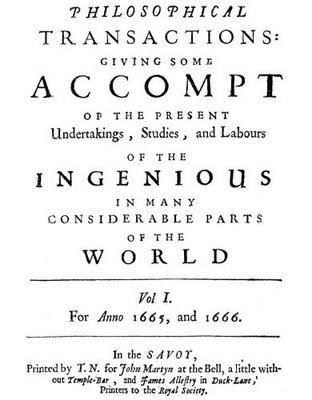Newton, Einstein and a monstrous calf

By Aussiegirl
Who could resist posting an article with the phrase "monstrous calf" in the title? The article states that the Royal Society's complete archive of its journals will be available online free for two months, but the website link isn't given, so I looked it up, and here it is: Welcome to the online journals of the Royal Society.
The description of the photograph: The first page of Philosophical Transactions of the Royal Society, which debuted in 1665. Robert Boyle contributed papers on thermodynamics and the appearance of a very strange calf to the first volume of the journal.
Newton, Einstein and a monstrous calf (September 2006) - News - PhysicsWeb
Newton, Einstein and a monstrous calf
Author, Darius Nikbin
21 September 2006
For the first time, the Royal Society is making the complete archive of its journals freely available online. For a two month period, the public will be able to access scientific papers going back to 1665, when Henry Oldenburg published Philosophical Transactions, the first-ever peer-reviewed journal in the English language.
The archive contains classic scientific papers from the likes of Isaac Newton, Edmond Halley, Michael Faraday, Albert Einstein, and Francis Crick. At the same time, the journals provide a direct glimpse into the fascinating history of science; particularly Philosophical Transactions, which in earliest years published papers on a wide variety of subjects and blurred the distinction between science and everyday reportage.
“The journals in question were for some time the most significant of their kind in the world, and certainly the most important publications in Anglo-American science until the prominence of Science, Nature and other journals,” said Rob Iliffe, reader in the History of Science at the UK's Imperial College, and Editorial Director of a project, which aims to make all Newton's writings freely available online.
In the first 1665 issue of Philosophical Transactions, Robert Boyle describes the experiments made into the nature of ‘cold’ in a paper titled “The Experimental History of Cold” (Phil Trans 1 8). Later in the same issue, Boyle also relates an story, this time from a butcher in Hampshire who had come across a deformed calf, titled “An account of a very odd monstrous calf”.
Another report published in 1681 describes the experiences of sailors off the north-east coast of North America. They discovered that after their ship was struck by and heavily damaged by lightning their compasses underwent a complete change in polarity (Phil Trans 14 520). “The North point was turned clear South…As for the other [compass] the North point stood West…The seamen were at first puzzled,” wrote Edward Lad, master of the Abermarle.
In the midst of such miscellany, a letter from a Professor of the Mathematics in the University of Cambridge, made its way into publication in 1671. Representing his earliest contribution to the history of knowledge, Isaac Newton describes the invention of a reflecting telescope in a letter containing his “New Theory about Light and Colors” (Phil Trans 6 3075)
Over the centuries, as semblances of the modern scientific disciplines emerged, from 1887 the Philosophical Transactions divided into two series: Series A (Mathematics and Physical Sciences) and Series B (Biological Sciences). “Early on, [Philosophical Transactions] was addressed to an educated and genteel audience, but later -- in the late 18th and early 19th century, it became more technical and the audience changed accordingly,” Iliffe told physicsweb.org. [....]


0 Comments:
Post a Comment
<< Home